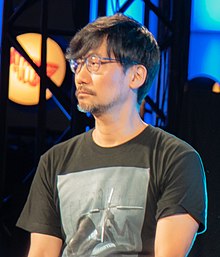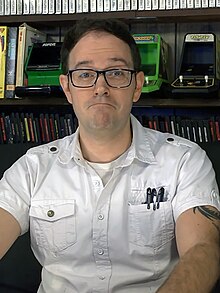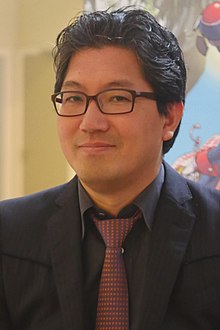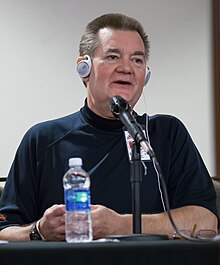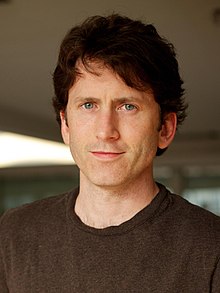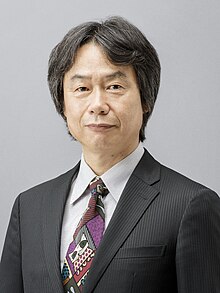Portal:Video games
The Video Games Portal

A video game, also known as a computer game or just a game, is an electronic game that involves interaction with a user interface or input device (such as a joystick, controller, keyboard, or motion sensing device) to generate visual feedback from a display device, most commonly shown in a video format on a television set, computer monitor, flat-panel display or touchscreen on handheld devices, or a virtual reality headset. Most modern video games are audiovisual, with audio complement delivered through speakers or headphones, and sometimes also with other types of sensory feedback (e.g., haptic technology that provides tactile sensations). Some video games also allow microphone and webcam inputs for in-game chatting and livestreaming.
Video games are typically categorized according to their hardware platform, which traditionally includes arcade video games, console games, and computer (PC) games; the latter also encompasses LAN games, online games, and browser games. More recently, the video game industry has expanded onto mobile gaming through mobile devices (such as smartphones and tablet computers), virtual and augmented reality systems, and remote cloud gaming. Video games are also classified into a wide range of genres based on their style of gameplay and target audience. (Full article...)
Featured articles –
Rare began working on Donkey Kong 64 in 1997, following the completion of Donkey Kong Country 3 (1996). It was conceived as a 2.5D platformer similar to Country before becoming a more open-ended game using the engine from Rare's Banjo-Kazooie (1998). A 16-person team with many recruits from the Banjo group finished it in 1999. It was published by Nintendo in North America in November and worldwide in December. Donkey Kong 64 was the first game to require the Nintendo 64 Expansion Pak, an accessory that added memory resources. The US$22 million marketing campaign included advertisements, sweepstakes, and a national tour.
Donkey Kong 64 received acclaim and was Nintendo's top seller during the 1999 holiday season; it ultimately sold 5.27 million copies worldwide. It won the 1999 E3 Game Critics award for Best Platform Game and multiple awards and nominations from magazines. Reviewers praised the exceptional size and length, but criticized its camera controls and emphasis on item collection and backtracking. Some cited its gameplay and visual similarities to Banjo-Kazooie as a detriment. Critics said Donkey Kong 64 did not match the revolutionary impact of Donkey Kong Country but was still among the Nintendo 64's best 3D platform games. (Full article...)
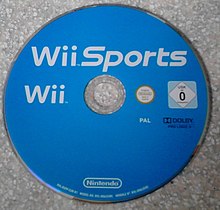
Wii Sports is a 2006 sports simulation video game developed and published by Nintendo for the Wii video game console. The game was released in North America along with the Wii on November 19, 2006, and in Japan, Australia, and Europe the following month. It was included as a pack-in game with the console in all territories except Japan, making it the first sports game included with the launch of a Nintendo system since Mario's Tennis for the Virtual Boy in 1995. The game was later released on its own as part of the Nintendo Selects collection of games.
Wii Sports is a collection of five sports simulations designed to demonstrate the motion-sensing capabilities of the Wii Remote. The five sports included are tennis, baseball, bowling, golf, and boxing. Players use the Wii Remote to mimic actions performed in real-life sports, such as swinging a tennis racket or rolling a bowling ball. The rules for each game are simplified to make them more accessible to new players. The game also features training and fitness modes that monitor players' progress in the sports.
Wii Sports was well-received by critics and audiences, and is considered one of the greatest games of all time. It was also a commercial success, selling 82 million copies worldwide, becoming the best-selling Nintendo video game, as well as the third-best-selling video game of all time and the best-selling game exclusive to one console. It has been featured on television in Wii commercials, news reports, and other programming. The game has become a popular means for social gatherings and competitions among players of varying ages. (Full article...)
Set in a fictional version of classical Japan, Ōkami combines Japanese mythology and folklore to tell the story of how the land was saved from darkness by the Shinto sun goddess Amaterasu, who took the form of a white wolf. It features a sumi-e-inspired cel-shaded visual style and the Celestial Brush, a gesture-system to perform miracles. The game was planned to use more traditional realistic rendering, but this had put a strain on the graphics processing of the PlayStation 2. Clover Studio switched to a cel-shaded style to reduce the processing, which led to the Celestial Brush concept. The gameplay is modeled on The Legend of Zelda, one of director Hideki Kamiya's favorite series. The game's name is a pun, as "ōkami" can mean either "great god" (大神) or "wolf" (狼) in Japanese.
Ōkami was one of the last PlayStation 2 games released prior to the release of the PlayStation 3. Although it suffered from poor sales, the game received critical acclaim, earning IGN's 2006 Game of the Year. The Wii version earned similar praise, though the motion control scheme received mixed reviews. A high-definition port, remastered by Capcom and HexaDrive, was released on the PlayStation 3 via the PlayStation Network in October 2012 and for retail in Japan in November, supporting the use of the PlayStation Move motion controller. The port was released for PlayStation 4, Windows, and Xbox One in December 2017 worldwide, for the Nintendo Switch in August 2018, and for Amazon Luna in April 2022. Mainstream adoption of the game has improved with the release of these remasters, and Ōkami is considered to be one of the best video games ever made, as well as an example of video games as an art form, aided by the improved art details and graphics resolutions. (Full article...)
In Islanders, players earn points by strategically placing buildings from their inventory onto a procedurally generated island. Earning points restocks the building inventory, eventually unlocking new types of buildings and the ability to move to a new island and continue the session. The session ends when no more points can be gained because no buildings are available or there is no space to place them. The overall goal of the game is to obtain the highest score possible in a single session.
Islanders was developed over seven months while the members of Grizzly Games were completing degrees in video game design at HTW Berlin. The developers were inspired by a mutual love of city-building games, and chose to embrace simplicity in designing Islanders because of the limitations of working with a small team. Employing procedural generation of new islands enabled them to keep the game's mechanics simple while still providing the player enough variety to make the game engaging for repeat sessions. (Full article...)
Takamasa Shiba and Takuya Iwasaki conceived the game as a hybrid between the popular Dynasty Warriors series and Namco's aerial combat game Ace Combat. It was Shiba's first project as a producer. The dark story was created by director Yoko Taro and Sawako Natori, who wrote the majority of the script. The music was written by Nobuyoshi Sano and Takayuki Aihara. A Europe-exclusive mobile adaptation was developed by Macrospace and published by Square Enix for Vodafone devices in August 2004. Drakengard sold well in Japan and received mixed to positive reviews in the west: reviewers praised the game's story and music, but were mixed about the graphics and criticized the gameplay for being repetitive. (Full article...)
Development began in 1997, during the English localization of Final Fantasy VII. The game builds on the visual changes brought to the series by VII, including the use of 3D graphics and pre-rendered backgrounds, while also departing from many Final Fantasy traditions. It is the first Final Fantasy to use realistically proportioned characters consistently, feature a vocal piece as its theme music and forgo the use of magic points for spellcasting.
Final Fantasy VIII was well received by critics. The game was a commercial success, grossing $151 million in its first day of release in Japan, and more than $50 million during its first 13 weeks in North America, making it the fastest-selling Final Fantasy title until Final Fantasy XIII, a multi-platform release. A Windows port followed in 2000, with the addition of the Chocobo World minigame. Final Fantasy VIII was re-released worldwide as a PSOne Classic on the PlayStation Store in 2009, for PlayStation 3 and PlayStation Portable, with support for PlayStation Vita in 2012. It was re-released via Steam in 2013. By August 2019, it had sold more than 9.6 million copies worldwide. A remastered version was released for Nintendo Switch, PlayStation 4, Windows, and Xbox One in September 2019, and Android and iOS in March 2021. (Full article...)
New Super Mario Bros. released with critical and commercial success, with many considering it as the main contributor in the revival of the 2D platforming genre. Praise went towards the game's improvements and introductions made to the Mario franchise and faithfulness to older Mario games, while criticism was targeted at its low difficulty level and lingering similarities to previous games. It was called one of the best games available for the Nintendo DS by several critics with some further calling it one of the best side-scrolling Super Mario titles. It sold over 30 million copies worldwide, making it the best-selling game for the Nintendo DS and one of the best-selling video games of all time. The game's success led to a line of sequels, starting with New Super Mario Bros. Wii (2009). (Full article...)
Did you know... -
- ... that classified documents of the United States were partially leaked onto a Discord server for the video game Minecraft?
- ... that the video game JFK Reloaded recreates the assassination of John F. Kennedy from the perspective of the killer?
- ... that fighting video game Panza Kick Boxing was endorsed by a French kickboxing champion who also supplied technical advice?
- ... that the Chicago Sun-Times credits JumpStart Toddlers as the first video game targeted towards babies?
- ... that MicroProse was formed to publish Hellcat Ace after Sid Meier boasted that he could design a better video game than Red Baron in a week?
- ... that LittleBigPlanet, a video game that allows the player to create levels, coincided with the rise of user-generated content?
- ... that a cheat code for the 2003 video game Hulk is hidden in a scene of the film it is based on?
- ... that a video game consisting solely of a clickable image of a banana was briefly the second-most played game on Steam?
- ... that the name of the video game mod series Bomba Patch was inspired by éclairs?
- ... that Goodboy Galaxy was the first commercially released video game for the Game Boy Advance in more than 13 years?
- ... that the 2005 video game Bokura no Kazoku was inspired in part by the birth of its creator's first child?
- ... that a cheat code in the video game Spyro: Year of the Dragon grants access to a near-complete copy of Crash Bash?
Selected biography –
Selected image -
Recent video game-related events
- September 12, 2024 – 2023–2024 video game industry layoffs
- Microsoft announces that it will lay off 650 Microsoft Gaming employees as part of cuts to its workforce. (Variety)
- August 15, 2024 –
- American video game magazine Game Informer discontinues publication after 33 years. The magazine's website is also shut down. (BBC News)
- May 24, 2024 – Uvalde school shooting
- Families in Uvalde, Texas, U.S., file a lawsuit against Daniel Defense and Activision Blizzard for creating the DDM4 V7 gun and promoting the weapon through the game Call of Duty, respectively. They also sue Meta Platforms for owning Instagram, which was used by the gunman. (AP)
Topics
Categories
Things you can do
In other Wikimedia projects
The following Wikimedia Foundation sister projects provide more on this subject:
-
Commons
Free media repository -
Wikibooks
Free textbooks and manuals -
Wikidata
Free knowledge base -
Wikinews
Free-content news -
Wikiquote
Collection of quotations -
Wikisource
Free-content library -
Wikiversity
Free learning tools -
Wiktionary
Dictionary and thesaurus



